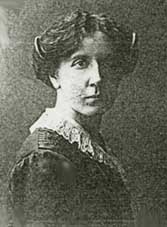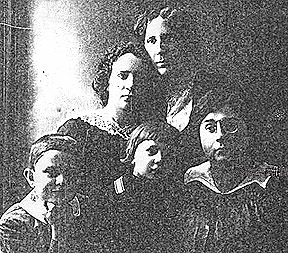


***Note that On May 12, 1828, Czar Nicholas crowned himself King of Poland. That is why this photograph reflects a Russian flavor.
GENERATION ONE:
Romuald Dabrowski, Sr. (the name Dabrowski has 36 different arms) was born in 1853, during the Russian Czars rule of Poland.
|
RUSSIAN CZARS: His Imperial Majesty, Nicholas I, Czar of Russia (reigned from December 1, 1825 - March 2, 1855) of the House of Romanov was the Czar in Romuald Dabrowski, Senior's life. Nicholas came to the throne at age 30. He crowned himself King of Poland on May 12, 1828, and was crowned as such with a Russian Crown. During Czar Nicholas I's reign, the Russian Herald's office required every family of the gentry/noble class, in the Empire, to furnish proof of its claim of being a member of the "privileged class." Two years after Romuald's birth, Czar Nicholas I died (March 2, 1855), of pneumonia, in the midst of the Crimean war. In 1863, there was an uprising in Russian Poland. However, it was crushed by the Czar's armies and eastern Poland again was a Russian province. Czar Alexander III died in 1894 (at age 50). Romuald would have been forty-one (41) years old at the time of this event. Alexander's son, Czar Nicholas II, then took his place as Czar. His Imperial Majesty, Nicholas II, Czar of Russia, ruled from September 1, 1894 - March 15, 1917. After Nicholas II signed an act of abdication on March 15, 1917, the power of Russia was given to the provisional government of liberal politicians. By April 1917, Lenin proposed they give the large estates of the nobility to be shared among the peasantry, an act that was sure to win him their support. This plan was opposed, and only the Bolsheviks liked the idea. Lenin fled to Finland around July 1917. The Bolsheviks held power and the Russian army disintegrated by October, since there were millions of deserters. In September, General Kornilov, the Russian Commander-in-Chief, attempted to seize power. His troops refused to march on Petrograd, so the attempt ended without so much as a shot being fired. On March 3, 1918, the Peace of Brest-Litovsk was signed. However, the peace did not help the Royal Family. On July 12, 1918, the Comrades of the Ural Soviets voted to execute the Romanov family. On July 17, 1918, they were dead. Fourteen Romanovs died between July 13th and July 18th, 1918. Those who survived fled to France, and the line continues to modern times.
|
Romuald's descendants would be witness to these events.

Romuald married Maria Koscuiszko(above). My family said she was the grand-daughter of Tadeusz Kosciuszko. However, Tadeusz did not marry, and he had only one brother, named Jozef Tomasz Koscuiszko, the family heir. Therefore, Jozef would have to be the connection, not Tadeusz. Her photo was taken in Moscow, Russia, Studio No 11 of the Dbgrobenko (?) Studio owned by H. Phillip.
GENERATION TWO:

1. Apolonia Dabrowska (above) d. 1960 in L~odz (pronounced wöj), a province in West Central Poland. Located 51:46N Latitude and 19:25 E. Longitude. L~odz is now the second largest town in Poland. It is known for its textile industry (50% of all Polish textiles are made in L~odz. During World War II, the Germans opened two large transit camps in L~odz for Polish prisoners of war. Of L~odz's 600,000 inhabitants only 300,000 survived WWII. Apolonia was unmarried and had a M.A. from St, Petersburg, Russia.
2. ? (Male) Dabrowski - was an engineer.
3. Henryk Dabrowski d. 1948. He lived near Vilno, Lithuania's capital, which was founded in 1322 by Duke Gediminas. Henry married Mary Maricka. This area was captured by the Poles in 1920, and was returned to Lithuania, by the Russians, in 1939. Henryk was a doctor. He had two daughters and a son:
Hanna had a daughter named Ewa Skarzanka. Ewa made two movies with Hanna: The"Zywot Mateusza" (in 1967) and "Polowanie na muchty" (1969), as mother and daughter.
Ewa was born on June 11, 1944, in Vilna, Lithuania, and died on March 18, 2005. Ewa is buried in the Evangelican Reformed Cemetary on Mlynarska Street in Warsaw, Poland. Ewa married Karol/Charles Stepkowski. He was born September 9, 1945, in Warsaw, Poland. He is an actor. Ewa and Karol's daughter, Catherine was born about 1974 in Warsaw. She is presently an actress too.


sent this photograph to his brother, Henryk at the University of St. Petersburg
 |
4. Tomasz Adam Dabrowski (right photo - taken by the B. Ostrowski Studio at Chelm (about 15-20 miles west of the River Bug), Lublin County, Poland, on Lublin Street. Chelm was 51:08 North Longitude and 23:30 E. Latitude. Tomasz was born on December 24,1885. Tomasz family was reported to be "a very rich man." His land was taken from him by the Communists. Tomasz was in Khazakstan for five years, like his son, Romuald. When he returned home, he died two days later, on December 24, 1944 (at age 59). In March 1942, about seventy-thousand Polish ex-prisoners of war assembled at Buzuluk. Poles were dying fast, since they were housed in tents in -50 o temperatures.
In Msgr. Dr. Zdzislaw J. Peszkowski's Polonia Semper Fidelis, he states: The worst Catholic clergy casualities of WWII were in the Chelm and Wloclawek dioceses.
His daughter, Maria, related the story of the condition of her father upon his return:
My Aunt Maria cried profusely, on the reporting of this story, on our meeting. She said it was rare for anyone to come back alive from Siberia, so no one knew how bad they were treated there. My great-grandfather they called a "bourgoises, rich capitalist," and he was punished for his good fortune. He returned a walking dead man. Before all this happened he married Kazimierza Maria Tyszezka (herbu Strzemie?). They were Roman Catholic. The photo of Tomasz (left above) was sent to a relative on February 11, 1901, via a photo postcard, it shows how vital he was before. The Soviet-German Treaty of Brest-Litovk was signed on March 3, 1918.
Tomasz owned a brewery in Brest, which is thought to be about 100 years old. Tomasz Adam Dabrowski is buried in Kobryn Cemetary.


This page was last updated on April 24, 2007
